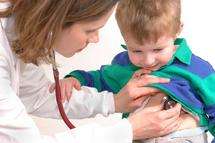Red flags could help identify children with serious infections

(PhysOrg.com) -- A set of warning signs -- or red flags -- that can be used routinely by doctors to help spot the few children that may have a serious infection from the many with minor coughs and colds, has been identified by a European team led by researchers at the Katholieke Universiteit Leuven in Belgium and Oxford University.
They were able to put together the list of red flags through a review of the available research evidence. Their systematic review is published in the medical journal, the Lancet.
Serious infections like meningitis, pneumonia or sepsis are rare in developed countries and can be difficult to diagnose among the many children coming into GP surgeries, paediatric assessment units and emergency departments. Detecting serious infections rapidly improves prognosis by allowing appropriate actions to be taken, such as referral to hospital.
‘For doctors, it’s a bit like finding a needle in a haystack,’ says Dr Matthew Thompson of the Department of Primary Health Care at the University of Oxford, a co-author of the study. ‘Serious infections are rare and getting increasingly rarer thanks to vaccinations. Identifying that one child out of all those many with minor ailments is difficult. It is complicated further as the child may be seen at any early stage of infection before it is possible to recognise its severity.’
Rapid breathing, poor blood circulation at the skin and extremities, and rashes of small purple red spots were identified as red flags that can help confirm the possibility of a serious infection. A high temperature over 40°C is a warning sign among children seen in surgeries and paediatric assessment units. However, the absence of these clinical signs could not rule out serious illness.
‘Doctors should routinely check for these warning signs in every sick child they see,’ says lead author Dr Ann Van den Bruel, who has just moved to the University of Oxford from KU Leuven and who is also a GP. ‘For example, not all GPs will check a child’s temperature, whereas we would now suggest this is done on all occasions.
’The doctor’s instinct or gut feeling is the best clinical predictor of serious infection. Parental concern is also a good warning sign that an illness is serious among children being assessed at GP surgeries.
‘As a GP, it’s important to always be alert to parents who are especially concerned about their child,’ says Dr Thompson, who is also a GP. ‘We should usually trust parents’ instincts, after all they will have nursed their child through many minor illnesses before and often can tell when something is different.’
Dr Van den Bruel adds: ‘Parents shouldn’t try to assess these red flags themselves, it would only add to any uncertainty or anxiety they may already be feeling. However, parents can take heart that we found they are very good at picking up signs that their child is unwell.
‘Parental concern is a good diagnostic indicator for something being seriously wrong, and doctors need to take that into account in combination with other clinical information.’
Having identified these red flags, the research team now aims to develop guidelines for what actions should then be taken for the best outcomes, so that children are referred to hospitals quickly and only where appropriate.














